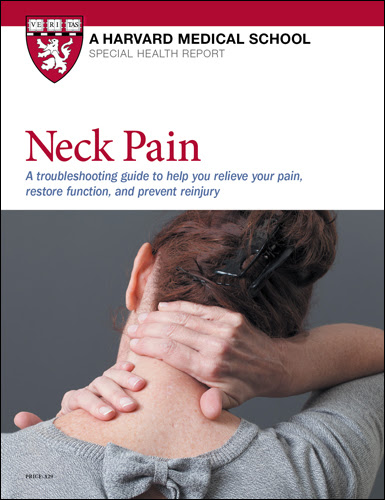
The 7 faces of neck pain

Image: iStock
If you're bothered by neck pain, you have plenty of company. Doctors estimate that seven out of 10 people will be troubled by such pain at some point in their lives. But if you were to ask each of these people to describe their neck pain, you would probably get seven different stories.
By clearly describing your specific neck symptom, or combination of symptoms, you can help your doctor determine what's wrong and how to help.
Here are the most common types of neck pain.
- Muscle pain. Aching or sore neck and shoulder muscles may occur in response to overexertion or prolonged physical or emotional stress. The neck muscles may develop hard knots that are tender to the touch, sometimes called trigger points.
- Muscle spasm. This is a sudden, powerful tightening of neck muscles. Your neck may hurt and feel tight or knotted, and it may be impossible to turn your head. When you wake up with a painful, stiff neck, that's likely a muscle spasm. Muscle spasm can result from a muscle injury, but it may also occur in response to a spinal disc or nerve problem, or even emotional stress. However, there is often no clear cause.
- Headache. Neck-related headache is most often felt in the back of the head and upper neck and is usually the result of muscle tension or spasm. Neck-related headache pain is usually dull or aching, rather than sharp; the neck might also feel stiff or tender. Moving your neck makes it worse.
- Facet joint pain. Often described as deep, sharp, or aching, pain in the facet joints (part of the vertebrae of the neck) typically worsens if you lean your head toward the affected side, and may radiate to your shoulder or upper back. Arthritis in the facet joints, as in other locations, may feel worse in the morning or after a period of inactivity.
- Nerve pain. Irritation or pinching of the roots of the spinal nerves causes pain that may be sharp, fleeting, severe, or accompanied by pins and needles. Depending on the nerve involved, the pain may shoot down the arm or even into the hand.
- Referred pain. Referred pain is pain in one part of the body that is triggered by a problem in another part of the body. For example, neck pain that worsens with exertion may indicate a heart problem, while neck pain that occurs when you eat may stem from a problem in the esophagus.
- Bone pain. Pain and tenderness in the cervical vertebrae are far less common than neck pain from the soft tissues. Bone pain needs medical attention because it may signal a more serious health problem.
There are many things you and your doctor can do to manage and relieve your pain, including a combination of self-help techniques and over-the-counter pain medications.
For more information on beating neck pain and getting back to the activities you love, buy Neck Pain, a Special Health Report from Harvard Medical School.
 |
Neck Pain
Featured content:
| • | Where bone, muscle, and nerve converge |
| • | Evaluating neck pain |
| • | Common causes of neck pain |
| • | Managing your pain |
| • | SPECIAL SECTION: Preventing further neck pain |
| • | ... and more! |
Click here to read more »






















.png)











No hay comentarios:
Publicar un comentario